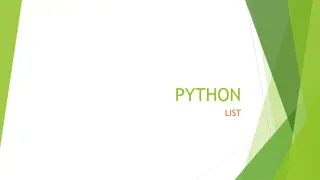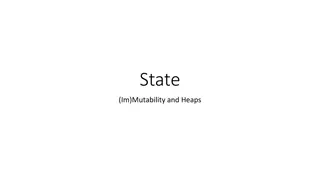
Mutability and Immutability in Programming
Explore the concepts of sharing, mutability, and immutability in programming through examples of copying, mutation, variable reassignment, object mutation, object identity, and object type. Learn how variables and objects behave differently, and understand the importance of object identity and type in programming.
Uploaded on | 3 Views
Download Presentation

Please find below an Image/Link to download the presentation.
The content on the website is provided AS IS for your information and personal use only. It may not be sold, licensed, or shared on other websites without obtaining consent from the author. If you encounter any issues during the download, it is possible that the publisher has removed the file from their server.
You are allowed to download the files provided on this website for personal or commercial use, subject to the condition that they are used lawfully. All files are the property of their respective owners.
The content on the website is provided AS IS for your information and personal use only. It may not be sold, licensed, or shared on other websites without obtaining consent from the author.
E N D
Presentation Transcript
Sharing, mutability, and immutability Ruth Anderson UW CSE 160 Winter 2016 1
Copying and mutation list1 = ["e1", "e2", "e3", "e4"] list2 = list1 list3 = list(list1) # make a copy; also list1[:] print list1, list2, list3 list1.append("e5") list2.append("e6") list3.append("e7") print list1, list2, list3 list1 = list3 list1.append("e8") print list1, list2, list3 2
Variable reassignment vs. Object mutation Reassigning a variable changes a binding, it does not change (mutate) any object Reassigning is always done via the syntax: myvar = expr size = 6 list2 = list1 Changes what the variables size and list2 are bound to Mutating (changing) an object does not change any variable binding Two syntaxes: left_expr = right_expr Changes something about the object that mylist refers to Examples: mylist[3] = myvalue expr.method(args ) mylist.append(myvalue) 3
New and old values Every expression evaluates to a value It might be a new value It might be a value that already exists A constructor evaluates to a new value: [3, 1, 4, 1, 5, 9] [3, 1, 4] + [1, 5, 9] mylist = [[3, 1], [4, 1]] # right hand side is a constructor An access expression evaluates to an existing value: mylist[1] What does a function call evaluate to? 4
An aside: List notation Possibly misleading notation: four score and seven years More accurate, but more verbose, notation: four score and seven years four score and seven years 5
Object identity An object s identity never changes Can think of it as its address in memory Its value of the object (the thing it represents) may change mylist = [1, 2, 3] otherlist = mylist mylist.append(4) mylist is otherlist True mylist and otherlist refer to the exact same object mylist == [1, 2, 3, 4] True The object mylist refers to is equal to the object [1,2,3,4] (but they are two different objects) mylist is [1, 2, 3, 4] False The object mylist refers to is not the exact same object as the object [1,2,3,4] The object identity test is is rarely used 6
Object type and variable type An object s type never changes A variable can get rebound to a value of a different type Example: The variable a can be bound to an int or a list a = 5 a = [1, 2, 3, 4] A type indicates: what operations are allowed the set of representable values type(object) returns the type of an object 5 is always an int [1, 2, 3, 4] is always a list 7
New datatype: tuple A tuple represents an ordered sequence of values Example: tuple four score and seven years tuple four score and seven years four score and seven years 8
Tuple operations Constructors Literals: Just like lists, but round the square brackets ("four", "score", "and", "seven", "years") Also (3, 1) + (4, 1) => (3, 1, 4, 1), etc. Queries Just like lists Mutators None! 9
Immutable datatype An immutable datatype is one that doesn t have any functions in the third category: Constructors Queries Mutators: None! Immutable datatypes: int, float, boolean, string, function, tuple, frozenset Mutable datatypes: list, dictionary, set 10
Not every value may be placed in a set Set elements must be immutable values int, float, bool, string, tuple not: list, set, dictionary The set itself is mutable (e.g. we can add and remove elements) Goal: only set operations change the set after myset.add(x) , x in myset True y in myset always evaluates to the same value Both conditions should hold until mysetis changed Mutable elements can violate these goals Aside: frozenset must contain immutable values and is itself immutable (cannot add and remove elements) 11
Not every value is allowed to be a key in a dictionary Keys must be immutable values int, float, bool, string, tuple of immutable types not: list, set, dictionary The dictionary itself is mutable (e.g. we can add and remove elements) Goal: only dictionary operations change the keyset after mydict[x] = y , mydict[x] y if a == b, then mydict[a] == mydict[b] These conditions should hold until mydictis changed Mutable keys can violate these goals 12
Pythons Data Model All data is represented by objects Each object has: an identity Never changes Think of this as address in memory Test with is (but you rarely need to do so) a type Never changes a value Can change for mutable objects Cannot change for immutable objects Test with == 13
Mutable and Immutable Types Immutable numbers, strings, tuples Mutable Lists, sets and dictionaries Note: a set is mutable, but a frozenset is immutable 14
Tuples are immutable Lists are mutable def updaterecord(record, position, value): """Change the value at the given position""" record[position] = value mylist = [1,2,3] mytuple = (1,2,3) updaterecord(mylist, 1, 10) print mylist updaterecord(mytuple, 1, 10) print mytuple 15
Increment Example def increment(uniquewords, word): """increment the count for word""" if uniquewords.has_key(word): uniquewords[word] = uniquewords[word] + 1 else: uniquewords[word] = 1 mywords = dict() increment(mywords, "school") print mywords def increment(value): """increment the value???""" value = value + 1 myval = 5 increment(myval) print myval 16
Increment Example (cont.) >>> def increment(uniquewords, word): ... """increment the count for word""" ... if uniquewords.has_key(word): uniquewords[word] = uniquewords[word] + 1 else: uniquewords[word] = 1 >>> mywords = dict() >>> increment(mywords, "school") >>> print mywords {'school': 1} >>> def increment(value): ... """increment the value???""" ... value = value + 1 >>> myval = 5 >>> increment(myval) >>> print myval 5 17













